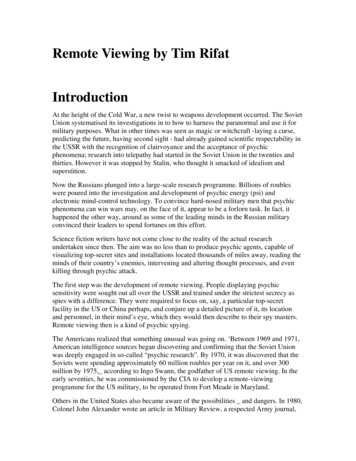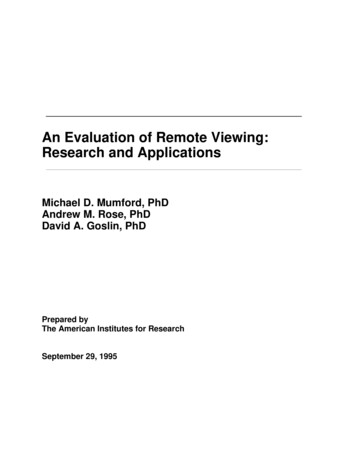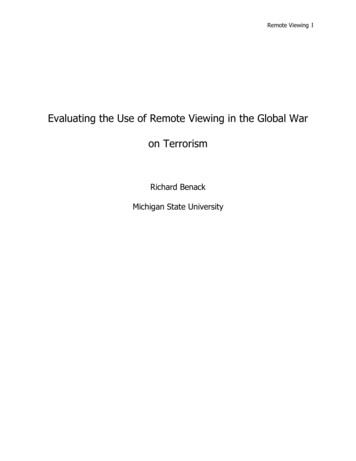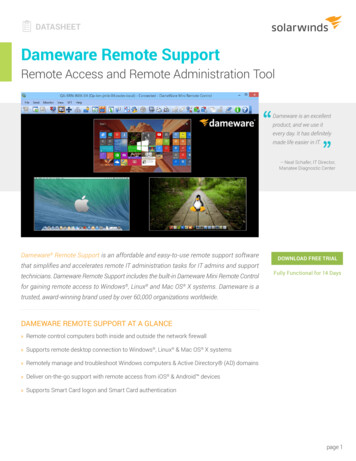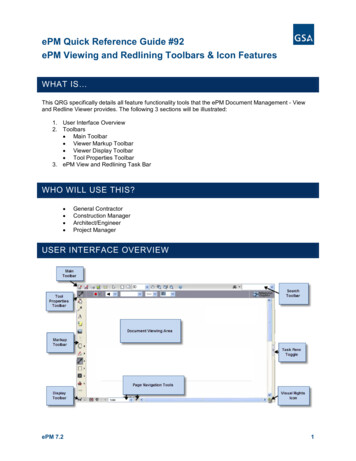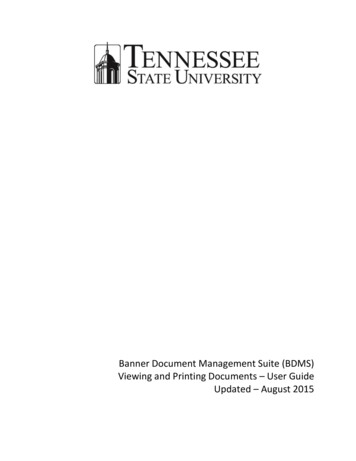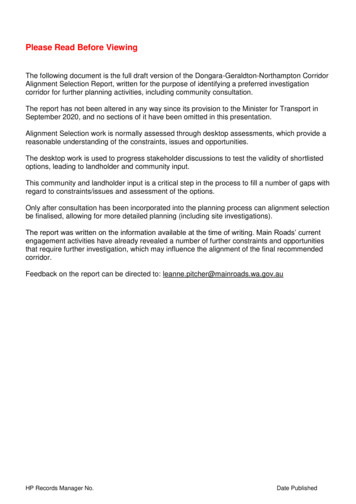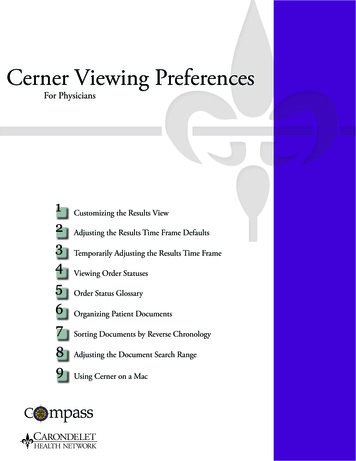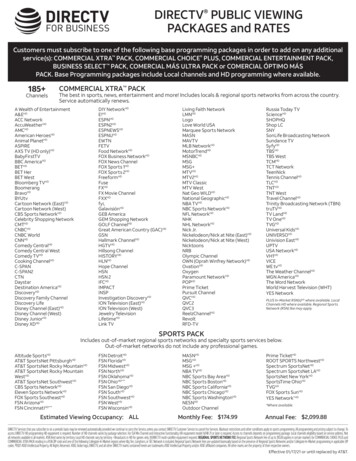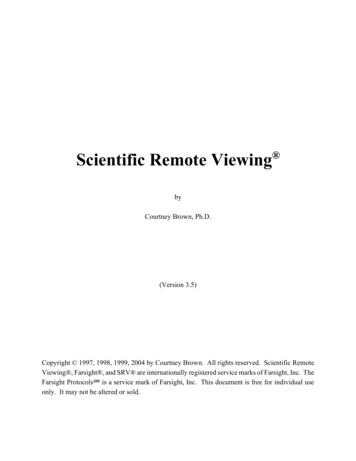
Transcription
Scientific Remote Viewing byCourtney Brown, Ph.D.(Version 3.5)Copyright 1997, 1998, 1999, 2004 by Courtney Brown. All rights reserved. Scientific RemoteViewing , Farsight , and SRV are internationally registered service marks of Farsight, Inc. TheFarsight ProtocolsK is a service mark of Farsight, Inc. This document is free for individual useonly. It may not be altered or sold.
CONTENTSSCIENTIFIC REMOTE VIEWING : AN OVERVIEWTARGET CUESPHASE 1PHASE 2PHASE 3PHASE 4PHASE 5ENHANCED SRV
Scientific Remote Viewing An OverviewThe method of remote viewing that is the focus here began to evolve in earnest in 1996 due toresearch that was and continues to be conducted at The Farsight Institute. This is a nonprofitresearch and educational institute based in Atlanta, Georgia, that is dedicated to the continueddevelopment of the science of consciousness using remote viewing as the primary research tool. Iam the director of the institute. Much of the research that is conducted is available for free on theInternet at the Institute’s web site, www.farsight.org.Underpinning all of the research is the hypothesis that all humans are composite beings. Thismeans that we have two fundamental aspects: a soul and a body. In the current jargon of remoteviewing, the soul is called the "subspace aspect" of a person. The physical realm of solid matter isboth separate from and connected to subspace. Once our physical bodies expire, we are no longercomposite beings, and we continue our existence as subspace entities.While we are composite beings, physical stimuli tend to dominate our awareness. Thismeans that our five senses (taste, touch, sight, hearing, smell) overshadow the more intuitiveawareness originating from the subspace side. In practical terms, this means that most people arenot aware that they even have a subspace aspect. In short, soul voices are deafened by the din of ourfive physical senses.In order to break through this noise, specialized techniques are required. In general, thesetechniques focus on shifting a person's awareness away from the five physical senses. It is notnecessary to force a shift in one's awareness toward the subspace aspect. This happens automaticallyonce a person’s awareness is no longer riveted on the physical side of life.For this reason, I advise combining the practice of remote viewing with the practice ofmeditation. The form of meditation that I enjoy is Transcendental Meditation (TM), or the moreadvanced TM-Sidhi Program. My preference is based on the fact that TM is a mechanicalprocedure, and it has no belief or religious requirement associated with it. The mechanics of TMare also quite stress free and relaxing. Again, these are only my preferences. Many people whoparticipate in other programs for the development of consciousness have also learned remoteviewing.Remote viewing is a natural process of a deeply settled mind. Remote perception works bestwhen it is not forced in any way. I have often said that the ancient seers were our first humanastronauts. While in a deeply relaxed state, they let their minds roam across the fabric of theuniverse, and some perceived what was there with surprising accuracy.1
The subspace mind, the intelligence of the soul, perceives and processes informationdifferently from the physical mind. All evidence suggests that the subspace mind is omnipresentacross space and time. It is everywhere at once. Using the capabilities of the subspace mind, remoteviewing involves no more than shifting one's awareness from one place and time to another. Youdo not go anywhere when you remote view. You do not leave your physical body. You do notinduce an altered state of consciousness. You merely follow a set of procedures that allows you toshift your awareness from one area of your intelligence to another.As physical beings, though, we must translate the information perceived by our subspaceaspects into physical words, pictures, and symbols so that this information can be conveyed to otherswithin the physical realm. Scientific Remote Viewing facilitates this translation. Remote viewingwould be impossible in the absence of the human soul, since it is physically impossible for anindividual’s conscious mind to perceive things without direct physical contact of some sort.COMMUNICATION WITH THE SOULSoul-level communication is not as easy as you might initially think. On one level,communication using the soul is as natural as breathing. While the theoretical principles underlyinghow this is done are quite simple, knowing with some degree of certainty that the communicationis accurate is more difficult.Subspace information has a mental flavor that is distinctly different from that obtained fromthe five physical senses. It is much more subtle and delicate. For this reason, sensory input fromthe five physical senses needs to be kept to a minimum both immediately prior to and during aremote-viewing session. That’s why one begins with meditation or other procedures to calm themind, and then to shift one's awareness away from the physical senses.The five physical senses are not the only hurdles confronting the remote viewer. Thethinking, judgmental, and evaluative processes of the conscious mind can also inhibit success. Theconscious mind can contaminate accurately perceived information. The amount of information theconscious mind has regarding the target during the remote-viewing session has to be minimized.Information coming from the subspace mind is typically called “intuition.” This is a feelingabout something which one otherwise would have no direct knowledge of on the physical level ofexistence. For example, many mothers say they know when one of their children is in trouble. Theyfeel it in their bones, so to speak, even when they have not been told anything specific regardingtheir child’s situation. SRV systematizes the reading of intuition.Using SRV, the information from the subspace mind is recorded before the conscious mindhas a chance to interfere with it using normal intellectual processes such as rationalization orimagination. With nearly all physical phenomena, a time delay exists between sequential and2
causally connected events. For example, when one turns on a computer, it takes awhile for themachine to boot up. When the institute teaches remote viewing to novices, we exploit the fact thatthere is approximately a three-second delay between the instant the subspace mind obtainsinformation and the moment when the conscious mind can react to this information. The subspacemind, on the other hand, apparently has instantaneous awareness of any desired piece of information.In general, the novice viewer using SRV protocols moves steadily through a list of, say, a fewhundred things at basically a three-second clip for each one. The tasks carried out in the protocolsare carefully designed to produce an accurate picture of much of the target by the end of the session.It is crucial to emphasize at this point that there must be no deviation from the grammar ofthe protocols. This is particularly true for novices. If there is a deviation, one only has to bereminded that it is the conscious mind that designs this deviation. When this happens, the subspacemind loses control of the session, and the data from that point on in the session are often worthless.TARGET COORDINATESScientific Remote Viewing always focuses on a target. A target can be almost anythingabout which one desires information. Typically, targets are places, events, or people. But advancedviewers also work with more challenging targets.An SRV session begins by executing a set of procedures using target coordinates. These areessentially two randomly generated four-digit numbers that are assigned to the target. The remoteviewer does not know what target the numbers represent, yet extensive experience has demonstratedthat the subspace mind instantly knows the target even if it is only given its coordinate numbers.The remote viewer is not told the target’s identity until after the session is completed.When I remote view, the only thing I am given prior to the beginning of my session is a faxor an e-mail from my "tasker" telling me the target’s coordinates. The tasker is someone who tasksor assigns a target. For example, if the target was the Taj Mahal, I would not be told to remote-viewthe Taj Mahal, since this would activate all of the information held by my conscious mind regardingthis structure, meaning that I would have a difficult time differentiating the remote-viewing datafrom memories or imagination. Instead, the tasker would tell me that the numbers were, say,1234/5678. My conscious mind would not know what target is associated with these numbers, butmy subspace mind would know the target immediately. A productive session would then includegood sketches of the structure, or at least aspects of the structure, together with written descriptivedata of the building and its surroundings, including people who may be in or near the building.3
THE SRV PROTOCOLSScientific Remote Viewing has five distinct phases, which follow one after the other duringan SRV session. In each phase the viewer is brought into either a closer or an altered associationwith the target. SRV is performed by writing, on pieces of plain white paper with a pen, sketchesand symbols that represent aspects of the target. The viewer then probes these marks with the pento sense any intuitive ideas. Since the subspace mind perceives all aspects at once, probing a markis a way of focusing attention on the desired aspect.The five phases of the SRV process are as follows:!!!!!Phase 1. This establishes initial contact with the target. It also sets up a pattern of dataacquisition and exploration that is continued in later phases. This is the only phase thatdirectly uses the target coordinates. Once initial contact is established, the coordinates areno longer needed. Phase 1 essentially involves the drawing and decoding of what is calledan “ideogram” in order to determine primitive descriptive characteristics of the target.Phase 2. This phase increases viewer contact with the site. Information obtained in thisphase employs all of the five senses: hearing, touch, sight, taste, and smell. This phase alsoobtains initial magnitudes that are related to the target’s dimensions.Phase 3. This phase is a sketch of the target.Phase 4. Target contact in this phase is more detailed. The subspace mind is allowedsignificant control in solving the remote-viewing problem by permitting it to direct the flowof information to the conscious mind.Phase 5. In this phase the remote viewer can conduct some guided explorations of the targetthat would be potentially too leading to be allowed in Phase 4. Phase 5 includes specializedprocedures that can dramatically add to the productivity of a session. For example, onePhase 5 procedure is a locational sketch in which the viewer locates a target in relation tosome geographically defined area, such as the United States.Categories of Remote-Viewing DataRemote-viewing data can be obtained under a variety of conditions, and the nature of theseconditions produces different types of data. There are six different types of remote-viewing data,and there are three distinguishing characteristics of the various types of data. The firstdistinguishing characteristic is the amount of information the viewer has about the target prior to thebeginning of the remote-viewing session. The second is whether or not the viewer is working with4
a person called a “monitor,” explained below. The third is determined by how the target is chosen.Type 1 DataWhen a remote viewer conducts a session alone, the conditions of data collection are referredto as “solo.” When the session is solo and the remote viewer picks the target (and thus has priorknowledge of the target), the data are called Type 1 data.Knowing the target in advance is called “front loading.” Front loading is rarely necessaryand should be avoided in general, but sometimes a viewer simply needs to know something abouta known target and has no alternative. Such sessions are very difficult to conduct from a practicalpoint of view. The viewer’s conscious mind can more easily contaminate these data, since theviewer may have preconceived notions of the target. Rarely do even advanced viewers attempt suchsessions. Any findings are considered suspect, and attempts are made to corroborate the data withother data obtained under blind conditions (see Type 2 data).Type 2 DataWhen the target is selected at random from a predetermined list of targets, the data are called“Type 2" data. For this, a computer (or a human intermediary) normally supplies the viewer withonly the coordinates for the target. Even if the viewer knows the list of targets, since sometimes theviewer has been involved in designing the list, only the computer knows which coordinate numbersare associated with each target. It is said that the viewer is conducting the session blind, whichmeans without prior knowledge of the target.Type 3 DataAnother type of solo, blind session is used to collect Type 3 data. In this case the target isdetermined by someone (a tasker). During training, viewers may (rarely) receive some limitedinformation regarding the target—perhaps whether the target is a place or an event. Advancedviewers are normally not told anything other than the target coordinates.Solo sessions can yield valuable information about a target, but trainees often find that morein-depth information can be obtained when someone else is doing the navigation. This other personis called a “monitor,” and monitored sessions can be spectacularly interesting events for the newremote viewer.Type 4 Data5
There are three types of monitored SRV sessions. When the monitor knows the target butcommunicates only the target’s coordinates to the viewer, this generates Type 4 data. These typesof monitored sessions are often used in training. Type 4 data can also be ver
meditation. The form of meditation that I enjoy is Transcendental Meditation (TM), or the more advanced TM-Sidhi Program. My preference is based on the fact that TM is a mechanical procedure, and it has no belief or religious requirement associated with it. The mechanics of TM are also quite stress free and relaxing. Again, these are only my preferences. Many people who participate in other .
